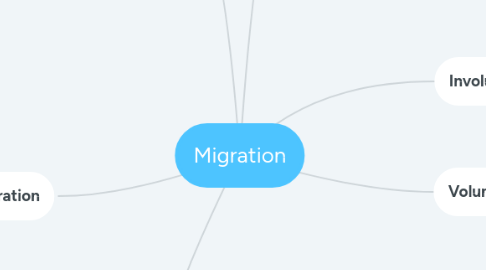
1. Push
1.1. Encourage people to emigrate from where they are to a new place
1.1.1. Political
1.1.1.1. War
1.1.1.2. Refugees fear their leader(s)
1.1.1.3. Fear persecution
1.1.2. Environmental
1.1.2.1. Drought
1.1.2.2. Famine
1.1.2.3. Disease
1.1.2.4. Hurricanes
1.1.3. Economic
1.1.3.1. Not enough jobs
1.1.3.2. Poor economy
2. 3 Waves of Migration
2.1. The first great wave of immigration began with the founding of the United States. These early immigrants came mostly from Northern Europe. Many were escaping from poverty or hunger. Some settled in cities, but most found land to farm.
2.2. In the late 1800s a second wave of immigrants began to arrive from eastern and southern Europe. Many were refugees fleeing war or persecution because of their religious beliefs. Most found work in the growing cities of the United States.
2.3. A third great wave of immigration began in the late 1960s and is still going on today. Between 1970 and 2003, about 24 million people moved to the United States. About 75 percent of them came from Latin America and Asia.
3. Effects
3.1. Immigration
3.1.1. Jobs: The US has long depended on immigrants for labor. A large amount of immigrants arrive with few skills meaning they accept low-paying jobs like farm laborers or cab drivers. Some immigrants who are successful may create businesses and employ other immigrants. Many native-born people believe immigrants are stealing jobs from them.
3.1.2. Taxes: Any immigrants who work and earn money pay taxes just as native-born Americans do. Many immigrants require services that are paid for by taxes such as language classes. These costs can be high and many taxpayers resent the costs.
3.1.3. Neighborhoods, Foods, and Holidays: Immigrants often bring new culture to areas and introduce Americans to new ways of life. Immigrants will often live in neighborhoods with other people from their homelands where they speak their native language and have food from their country. Immigrants also introduce new holidays like St. Patrick's Day or Cinco De Mayo.
3.2. Emigration
3.2.1. Brain Drain and Gain: When people emigrate they take with them their knowledge and skills. Often when these skilled people leave they will send back money to their family or friends. These payments are known as remittances.
3.2.2. Divided Families and Community Improvements: When young people leave to go find better jobs and improve their lives, it can tear families apart. This can be positive as well because the families can use any remittances to better their own lives and communities.
3.2.3. Working for Better Government: Some refugees escape political problems in their homeland and come to the US to become more educated. Valdas Adamkus escaped Lithuania and it's Soviet rule, went to college in Illinois and got more political experience, before returning to Lithuania and freeing it from the Soviet Union.
4. Pull
4.1. Attract people to a new place and encourage them to immigrate there
4.1.1. Family
4.1.1.1. Unite divided families
4.1.1.2. Men immigrate and establish a life then reunite with wives and children
4.1.2. Education
4.1.2.1. Children can attend better schools
4.1.3. Quality-of-Life
4.1.3.1. Create better lives
4.1.3.2. Sense of safety
4.1.3.3. Better jobs and wages

